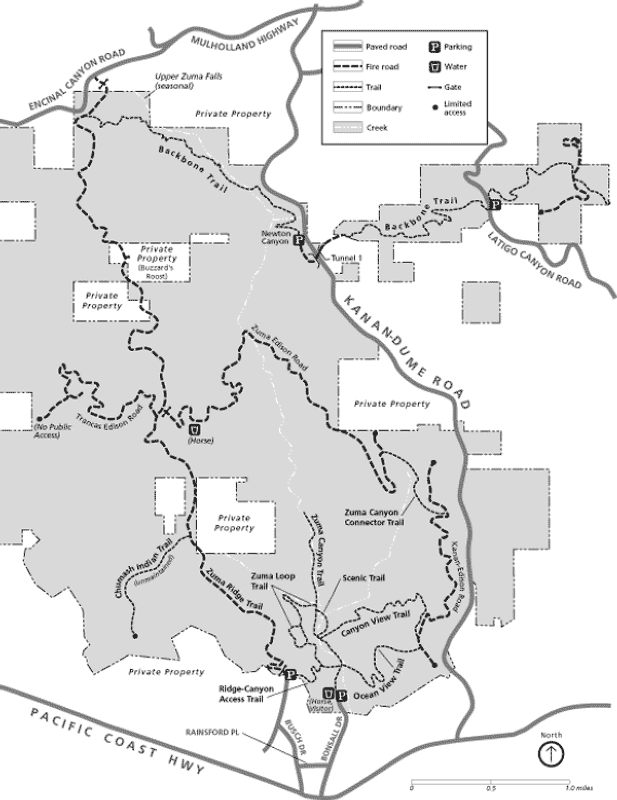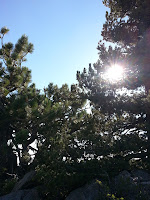 The Lost Coast is in the King Range National Conservation Area, about 10 hours from Santa Monica. Many of the reviews on this hike describe it as moderate to strenuous. Even though there is relatively little elevation gain, it is tough because of the boulders and cobblestone and soft sand on the beach. Unless you get lucky and are able to find a spot on Buck Creek to break up the last day hike, you will be hiking 10 miles on the last day.
The Lost Coast is in the King Range National Conservation Area, about 10 hours from Santa Monica. Many of the reviews on this hike describe it as moderate to strenuous. Even though there is relatively little elevation gain, it is tough because of the boulders and cobblestone and soft sand on the beach. Unless you get lucky and are able to find a spot on Buck Creek to break up the last day hike, you will be hiking 10 miles on the last day. The best way to hike the lower trail, which is 25 miles one way, is to park a car at Shelter Cove (Black Sands Beach) and take a shuttle to the north trailhead, which is at Mattole Beach, then hike back to your car.
To get to Shelter Cove, take the 101 to the Garberville exit. You will need to stop at Whitethorn to pick up a bear canister ($5), get a tide chart, and fill out a permit (free) at BLM main office on the way (its on Shelter Cove Road). Then continue to Black Sands Beach parking lot at the very end of the road, by turning right and going up the hill to the bluff. There are signs at the turn. It is about 1 1/2 hours after you exit from the 101 to get to Black Sands Beach because of the windy road.
There are a few shuttle services that will drive you to the north to start your hike at Mattole Beach. After looking on Yelp, I chose Lost Coast Adventure Tours with Blu. He was very informative, helpful, and patient with us as we arrived late and gathered our things. (707) 986-9895. It is about a 2 1/2 hour drive, even though it is 25 miles on the beach, it is a very windy road and takes awhile!
To break up the drive, I highly recommend a place I found on airbnb in Ukiah. We stayed there before the hike, and also after the hike. Nikola was the sweetest hostess and left things in our room like bandaids and tiger balm, and fresh cut roses. The thing we appreciated the most was the huge double shower and double sinks in the bathroom!
https://www.airbnb.com/rooms/9924417
I went with my son who is a monster hiker. I love to hike, but I can't keep up with him! We decided to do the hike in three nights and four days. There are many hikers who opt to do it in two nights and three days. We even heard from Blu that someone ran the entire trail. Even at the pace we did, I felt rushed. I could have spent two more nights there in some of the camping spots we passed that were vacant and absolutely beautiful. I guess it all depends on what you want out of this magical, serene, rugged place. I want to say that the times when I stopped and filled water at the stream, or sat on a perfectly curved driftwood chair, were the times that I saw the wildlife and I was so happy that I took that moment to stop! Also, plan but be prepared to change your itinerary. You may want to hike more or less on some days than you expected!
Also note that you will more than likely encounter forest rangers on your hike and they may ask you four important questions that you should know the answers to or risk a fine: know if you allowed to make a fire (depending on the dryness and the season), where to go to the bathroom (below the high tide mark, not in the forest near drinking water), have your permit tag on one of your packs, and have a bear canister!
Day 1 - Mattole Beach to Sea Lion Gulch and beyond!
Approximately 6 miles in 3 hours
50 feet elevation gain
Lots of hard pack dirt, some soft sand and cobblestones
One point at the 2.5 mile mark, where you will need to make it around the point before high tide.
We got off the shuttle around 3:00 p.m. and started our hike. It was perfect hiking weather with 61 degrees and some clouds. We checked the tides and knew we could make it around the point without a problem. There were a few hikers starting out at the same time but we waited for them to go and really had the trail to ourselves. The Punta Gorda Lighthouse was built in 1910 and overlooks a rookery of elephant seals at 3.75 mile mark, and you can climb up the rickety and tiny metal spiral staircase to the top for an amazing view! The wind picked up, so we opted not to camp at Sea Lion Gulch and found a pointed boulder on the other end of the gulch that offered a great windbreak. It wasn't big enough for two tents, but my two-person tent sufficed for both of us.
Day 2 - Sea Lion Gulch to Spanish Flat
Approximately 7 miles in 4 hours
120 feet elevation gain
4 miles of soft sand, cobblestone, and boulders on the beach
4 miles of beach that is impassable at high tide
We checked our tide chart as the first part of our hike would have to be done before high tide. Low tide was at 2:14 p.m. at 1.84 feet. The four foot section is impassable at 3.5 feet. You should pass the "impassable during high tide" 2-3 hours before the low tide mark., because low tide is the low point and will start to rise again after this. We slept in and ate before we packed up. We started hiking around 11 a.m. and even though I was nervous about making the 4 mile trek in time before the tide rose, we did not have a problem. There are plenty of places to fill up water on this day as you cross at least three creeks.
There is an overland detour that is easy to miss if you do not look for it. The visual cue is a balancing rock. Look up once you see the rock and you will see the post for the trail.

 If you look up the ridge to the left, you will see the post for the LCT sign and the mark of the trail. The trail continues through the gulch.
If you look up the ridge to the left, you will see the post for the LCT sign and the mark of the trail. The trail continues through the gulch.Anything past the balancing rock IS IMPASSABLE even during low tide, so if you miss the trail you could get in trouble.
There is also a junction for the Cooskie Creek Spur trail. You want to continue on the Lost Coast trail the entire trek.
We passed Randall Creek which is at the north end of Spanish Flat. It was closed for 1/4 mile to camp, but it was an amazing spot to stop and have lunch.

We hiked up the bluff from here and stayed on the beach in Spanish Flat for the second night. We set up camp and had tons of time to read and hang on the beach. There is a little makeshift dam at the creek and a small pond to wade in, which I used to wash my face and clean up a bit! It rained at night but cleared by the morning.

Day 3 - Spanish Flat to Miller Flat
Approximately 7 miles in 4-5 hours
100 ft. elevation gain
No impassable sections
The first part of the day we were hiking on the beach and slowly maneuvering on the boulders and rocks. At 4.6 miles, the trail continues on top of a terrace, and on to grassy fields. At mile 7 we reached Big Creek and just beyond that, in the forested part is Miller Flat and where we decided to camp. I could not believe we were the only ones camping in the forest! We kept running into two rather large groups of boy scouts, but never seemed to be bothered by them during camping times! It rained again this night but once again cleared by the morning. The rain made the aromas of the woods pop out, and I enjoyed my camp spot on the sweet smelling grass. There are plenty of animals that live here, including a scolding raccoon that circled both our campsites and the boyscouts camp and kept us awake as it looked for food. The deer seem almost tame and unaffected by humans. And watch out for snakes that like to seek shade under driftwood. I spotted one on one of the larger driftwood near the campsite on the beach.

Day 4 - Miller Flat to Black Sands Beach
Approximately 10 miles in 5 hours
75 foot elevation gain
Impassable section from Miller Flat to Gitchell Creek - approximately 3.9 miles long.
It felt good to sleep in once again as we waited for high tide to peak. Our chart showed high tide at 10:04 a.m. at 4.1 feet. The strategy is to start as close as you can to this peak but still make it safely around the points on the beach. We left at 11:30 a.m. and it was still rather high and we had to scurry around some of the points in between wave sets. There will be plenty of opportunities to fill up water during this trek. You will pass two camp areas, Shipman Creek and Buck Creek, and there also seems to be water leaking from every cliff as well! This is a tough trek, as you will be navigating on boulders and hoping that you won't sprain an ankle! There is plenty of soft sand too until you reach two significant boulders on the beach. This is at mile 8.2 and you will be heading into the home stretch. We were so excited to see the boulders! The beach also widens and the sand is harder packed near the waves. You will be able to see the homes on Shelter Cove, and the trailhead up to the parking lot is before the homes.








































